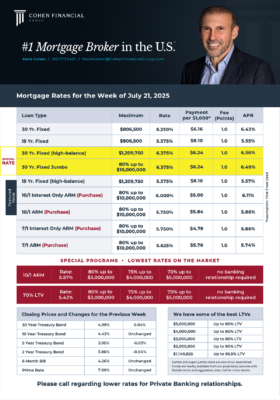Mortgage Markets Steady Amid Mixed Data
It was a relatively quiet week last week for mortgage markets. The major inflation data was a little weaker than expected, but consumer spending was a good deal stronger than forecasted. The net result was that mortgage rates ended last week nearly unchanged.
Core CPI Rises, Tariff Pressures Emerging
The Consumer Price Index (CPI) is one of the most closely watched inflation indicators released each month. To reduce short-term volatility and get a better sense of the underlying inflation trend, investors look at core CPI, which excludes food and energy. In June, Core CPI rose just 0.2% from May, below the consensus for an increase of 0.3%. It was 2.9% higher than a year ago, up from 2.8% last month, which was the lowest annual rate since March 2021.
Tariff Effects Emerging in June CPI
Although this annual rate has dropped sharply from a peak of 6.6% in September 2022, and from 3.9% in January of last year, it is still far above the readings around 2.0% seen early in 2021, which is the stated target level of the Fed. Shelter (housing) costs continue to be a primary reason why progress on bringing down inflation remains challenging. By contrast, used vehicles, new vehicles, and airfares posted notable price declines in June. Investors also focused on significant price increases for items affected by tariffs such as home furnishings and apparel, which may continue in the future.
June Core PPI Flat at 0%
Another significant inflation indicator released last week, which measures costs for producers, also came in below the expected levels. The June core Producer Price Index (PPI) was flat from May, well below the consensus forecast for an increase of 0.2%. It was 2.6% higher than a year ago, down from an annual rate of 3.0% last month and the lowest since April 2024.
Retail Sales Surge
Consumer spending accounts for over two-thirds of U.S. economic activity, so investors pay close attention to the monthly Retail Sales report as a key measure of the health of the economy. Retail sales in June rose 0.6% from May, far more than the consensus forecast for an increase of just 0.2%, and they were a solid 4% higher than a year ago. Particular strength was seen in motor vehicles, home improvement, and apparel. In addition, spending at restaurants and bars increased significantly in June, despite some concerns that consumers are scaling back. Eating out tends to be one of the first discretionary items cut when people are trying to save money.

Mortgage Rates for the week of 7-21-2025
